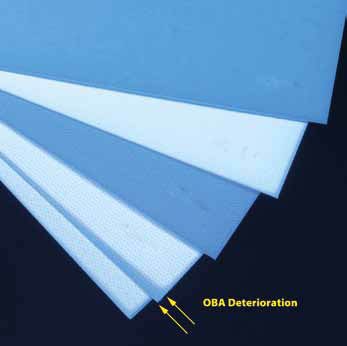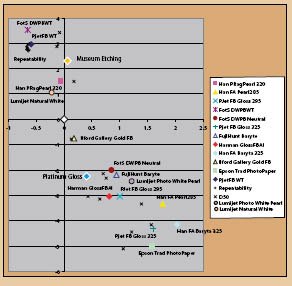articles/Paper/paperwhite-page2
Paper White - what are you looking at? - part 2 of 1 2 3
by Mike McNamee Published 01/02/2012

Fluorescence: Measure a paper's fluorescence according to TAPPI T452 / ASTM D985. Opacity: Measure a paper opacity according to CGATS.5 / ISO 2471. White backing compliance: Check the compliance of a white backing used to measure colour patches as per ISO 13655.
Black backing compliance: Check the compliance of a black backing used to measure colour patches as per ISO 5-4.
What is Brightness?
Brightness is a measurement of light reflectance of a specific wavelength of blue light. Simply put - brightness represents a more narrow measurement of light reflectance than whiteness.

Here is another confusing gem, this time from a 2011 review article by Axiphos GmbH, a German company: "Considering these points is to conclude that brightness has become an obsolete parameter in modern paper manufacturing and its use should be dropped."
What is Fluorescence?
By comparison, this one is easy and everybody seems to agree on the topic. In order to boost the appearance of paper brightness, the manufacturers add optical brightening agents (OBAs aka FWAs Fluorescent Whitening Agents). These have the effect of absorbing low wavelength light (typically in the ultra violet part of the spectrum) and re-emitting light of lower wavelength (but in the visible part of the spectrum, usually blue). This promotes the appearance, making the paper seem brighter, providing there is UV about (and there usually is). It is measured by taking two readings, one directly onto the paper and one with a thin UV filter between the paper and the instrument.
The fluorescence parameter is then calculated from the difference in the readings.
What does it mean and does it matter?
The answer to the second part is yes, it does matter; refined viewers are sensitive to subtle variations in the appearance of their prints. How does it affect the 'look' of a print? A bluer, cooler (ie brighter) paper has more punch, the Americans use the word 'pop'. However, it also depresses the warmth of skin tones and all colours on the warm part of the spectrum, making skin seem more magenta. Brighter papers are less accurate for proofing purposes for the same reason but a brightened paper could be a better mimic of what will come off the press if the printing stock is also brightened. Warm papers are more flattering to skin tones and also easier on the eye for extended viewing (eg when reading a novel).
A significant downside of OBAs is their fading with time. They lose their ability to fluoresce and so the paper reverts back to its base colour, always more yellow. If this happens unevenly, usually at the edges of a print then it is an obvious flaw. There is no point in putting a brightened paper behind a UV-resistant glazed frame as the enhanced brightening will be filtered out! The same is true of using a UV varnish on a brightened paper, any increase due to OBAs will be filtered out.
Please Note:
There is more than one page for this Article.
You are currently on page 2
- Paper White - what are you looking at? page 1
- Paper White - what are you looking at? page 2
- Paper White - what are you looking at? page 3
1st Published 01/02/2012
last update 09/12/2022 14:57:23
More Paper Articles
There are 26 days to get ready for The Society of Photographers Convention and Trade Show at The Novotel London West, Hammersmith ...
which starts on Wednesday 14th January 2026





